
Annual Health Fair, July 26

syəcəb

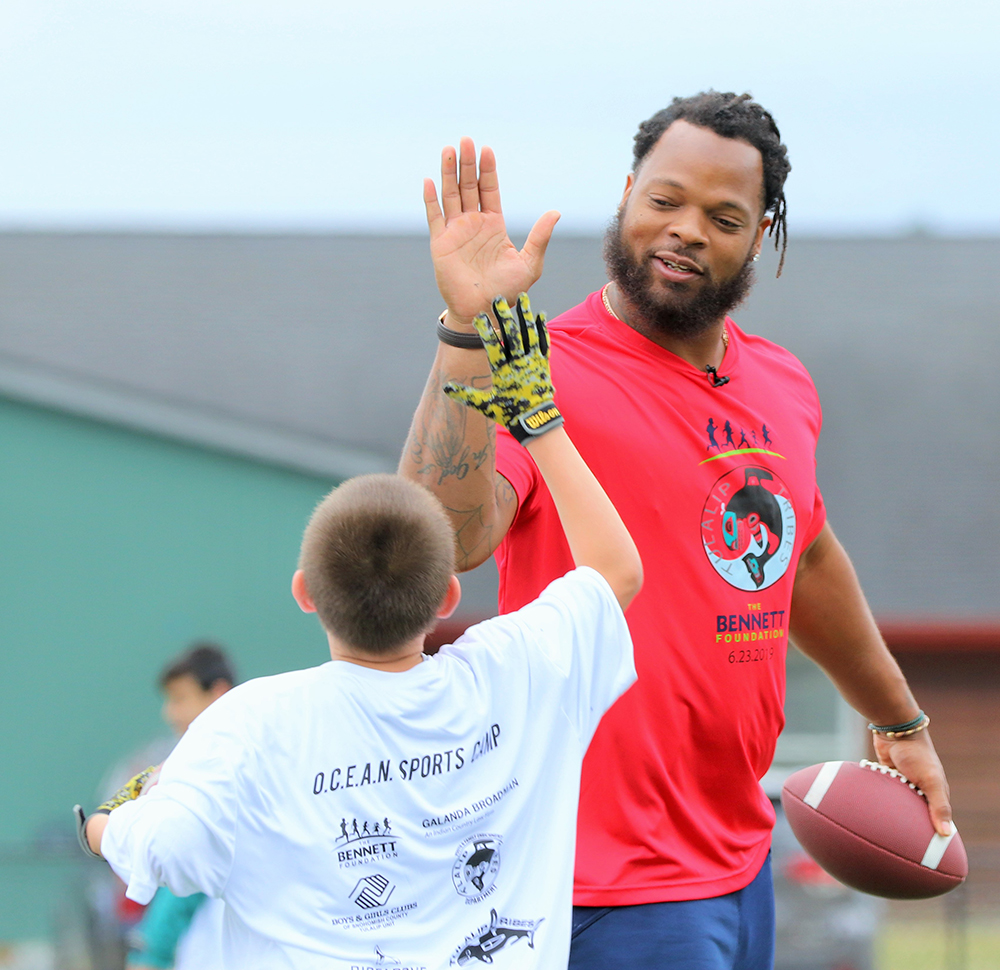
By Micheal Rios, Tulalip News
The Pacific Northwest is Seahawks country. From Blue Fridays to rallying chants of “Sea-Hawks!”, the 12th Man is synonymous with Seahawks fandom. But even for the most devout of fan bases, it’s a rarity for beloved players to make themselves accessible to their adoring fans, let alone those who live on a small reservation an hour outside of Seattle. Amazingly, Super Bowl champion Michael Bennett proved to be the rare exception when he held an inclusive football camp on the Tulalip Reservation.
“It’s important to give tribal people, the original people of Seattle, the opportunity to be with the players they follow and love to watch on Sundays,” said Bennett. “Even though their circumstances are different, I want to help empower them to fight for what they want to fight for while always being the people they want to be.”

Nearly 250 kids between ages 7-18 years old participated in the highly anticipated O.C.E.A.N. sports camp held at the Tulalip Sports Complex on Sunday, June 23. Registration was completely free of charge for any youth of Tulalip and surrounding communities thanks to collaborating partners Rise Above, Boys & Girls Club of Snohomish County, Tulalip Tribes, Galanda Broadman and The Bennett Foundation.
“We’ve been using football camps as a way to promote healthy lifestyle choices and overall wellness for close to seven years now,” explained Bennett Foundation cofounder Pele Bennett, Michael’s wife. “The Foundation has been fortunate to host camps in other states and countries. Even though Michael is no longer a Seahawk, we love being able to return to Seattle where we are so welcomed and make an impact to the local communities.”
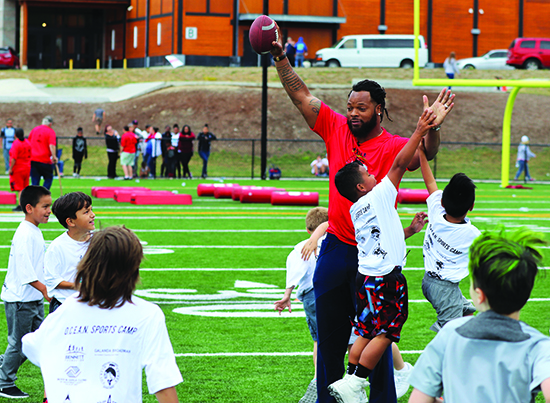
During his five-year tenure as a Seahawk, Bennett was a defensive stalwart with an uncanny ability to get after the opposing team’s quarterback. Even casual fans remember his celebratory sack dance that happened so frequently it earned him three consecutive trips to the Pro Bowl and his team back-to-back Super Bowl appearances. Now, he’s using his abilities and larger-than-life personality to tackle a new opponent, childhood obesity.
“When you look at obesity and diabetes in our community, the black and brown communities around the world, it’s rampant,” said Bennett. “Food and nutrition are the biggest barriers to the overall well-being of our peoples. People don’t have Whole Foods everywhere they go. For tribal people, they don’t have access to their traditional foods. It’s important to have a sense of compassion and empathy for what other people are going through, and work together to break down those barriers that divide us.”
Bennett and his wife Pele started The Bennett Foundation with the goal of raising awareness about obesity and providing communities with educational opportunities to learn how to live a healthy and active lifestyle. As one of the longest running programs of The Bennett Foundation, O.C.E.A.N. is an acronym for fighting Obesity through Community, Education, Activity and Nutrition. The objective of the O.C.E.A.N. sports camp is to educate the community on healthy food choices and promote physical fitness as a family.

Every camp is designed specifically for each individual community, and may feature a health expo, a family fitness clinic, or an exciting fitness challenge. For Tulalip, the emphasis was on physical fitness through a variety of football drills and skill building exercises that were enjoyed by all youth participants.
Among the hundreds of eager kids who made it out on the picture-perfect summer day in Tulalip were families journeying from as far south as Olympia and as north as Nooksack. Of course, many local parents and guardians took full advantage of the on-reservation event to have their young athletes meet a sports superhero they’ve only seen on TV playing for their favorite football team.

Excited 8-year-old Annavay Hatch and 7-year-old Lila Joel described meeting the former Seahawks Pro Bowler as “Good. Wait, no, it was great!” Both ran multiple passing routes in the hopes of catching a football thrown by Bennett. Annavay beamed a huge smile after catching a Bennett pass, while Lila was unable to, but still had lots of fun trying. “I caught zero. The ball was slippery, but I came really close a couple times,” she said.
Making a memory she’s sure to never forget, 11-year-old Noelani Cultee ran a Doug Baldwin-like comeback route, jumped up, extended her arms as far as she could and made a highlight catch by bringing in a Bennett pass thrown well above her head. Following the impressive play she boasted, “That was so cool. I thought I wasn’t going to catch it because I could feel it slipping through my fingertips, but I held onto it!”

Countless youngsters made the most of their opportunity to catch a pass from the Super Bowl champ. One after another managed to reel in a pass and after each successful attempt they’d quickly run the ball back to Bennett and give the professional football player an ecstatic high-five. At one point Bennett joked he’d connected on so many touchdown throws that the Seahawks should sign him as their backup quarterback.
As the kids motioned around the football field transitioning from station to station they completed a number of physical activities. Aside from the countless curl, post, slant, and out routes ran, they also engaged in agility ladders, tested their lateral reactions with cone drills, jumped mini hurdles, and got stronger with lunges, squats and pushups just like the pros. With a DJ providing musical hits to workout to, there were only positive and encouraging vibes in the air.
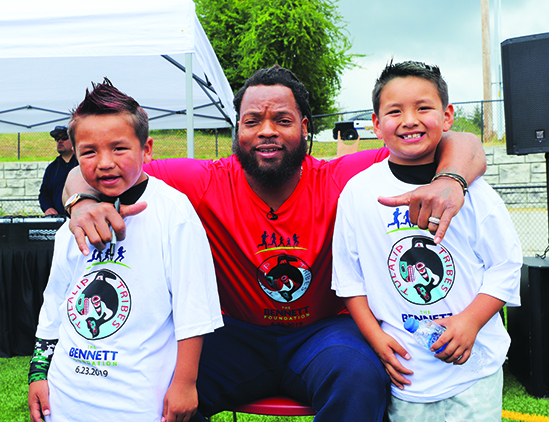
“You can just feel the positive energy that’s here in this moment,” marveled Jaci McCormack (Nez Perce), founder of the nonprofit Rise Above which uses sports to educate and empower native youth to live healthy lives. “There’s no way to measure how these camps and athletic clinics impact these kids long term, but if we could measure that I think it would be a significant.
“These kids are going to remember catching a pass from Michael Bennett for the rest of their lives,” continued Jaci. “It’s not necessarily about football, it’s about Michael and all the volunteer coaches choosing to be here and spend time with them. We care about them, they are our future and for them to choose to make positive choices every day is the ultimate goal. Experiences like this speaks volumes to our kids and lets each of them know they matter.”
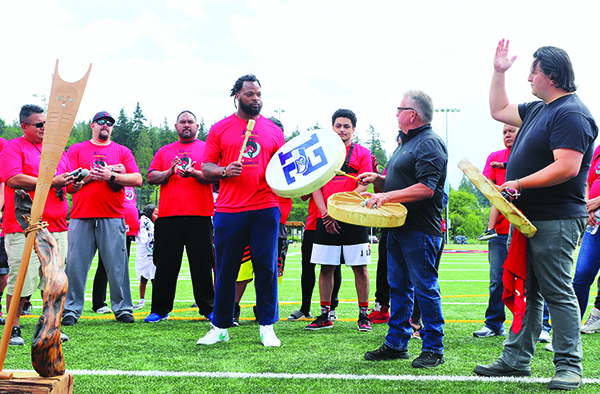
Following the football-filled afternoon, everyone gathered in the end zone to conclude the event with a traditional song. Bennet was gifted a unique ‘Salish Song’ paddle and commemorative 12th Man hand drum. Generously giving of his time, the NFL defensive end stuck around for an additional hour and a half to ensure every camp participant and adoring fan, including many parents and volunteer coaches, received an autograph and one-on-one picture.
“When you interact with tribal people, you feel the spirit of everything around, the essence of where you are,” reflected Bennett as he walked off the field and took in the scenery that is Tulalip Bay. “Here there’s a culture behind everything, there’s a significance to everything being done. It’s powerful, something I’ll never forget.”


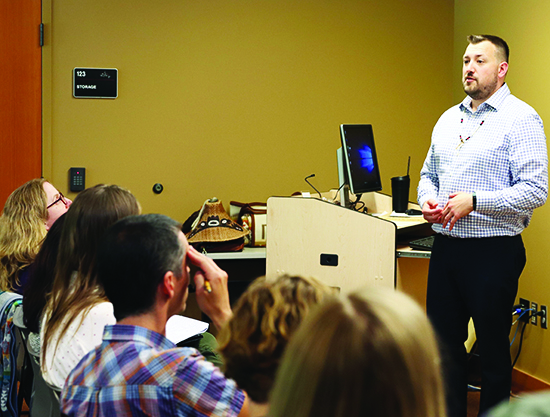
By Kalvin Valdillez, Tulalip News
“Change can either mean good or bad,” expressed a local environmentalist to an audience of about sixty. “I know it’s only semantics, but I think we should start addressing it as it is, a climate crisis.”
A disruption of the food chain is currently occurring in the Pacific Northwest as sea level rise, pollution and ocean acidification are causing an alarming decrease in the salmon and orca populations. Climate change is not only affecting the Salish waters, but also threatening tribal ancestral lands as wildfires have unfortunately become a statewide yearly occurrence, and the recent increase of outdoor recreationalist are interfering with tribal spiritual and hunting practices.
A recent report by Seattle Times states that due to the warm weather this past May, the statewide snowpack percentage is only at 58% of the normal average, while Snohomish County’s snowpack had the lowest percentage, measuring at 29%. As the snowpack melts, it delivers water into local streams, rivers, lakes, estuaries and bays. As a result of this year’s dry climate, the state is gearing up for a summertime drought and preparing for a series of wildfires.
Climate change is inevitable and scientists are now reporting the world will feel the extreme effects of global warming sooner than anticipated. Several tribes are at the forefront, fighting to save Mother Earth and slow down the process of climate change by raising awareness, protesting big oil and energy companies, and dedicating their efforts to recover the once abundant salmon population. More often than not, the tribes are joined by a handful of environmental agencies who are fighting alongside for the same cause.
This past January, the Tulalip Tribes Natural Resources department organized a daylong presentation for local outdoor recreational groups in an effort to establish a positive working relationship and also equip the groups with a basic knowledge of treaty rights. The event was such a success, they decided to host another workshop, on June 20 at the Hibulb Cultural Center (HCC), tailored to surrounding environmental organizations.
“We have so many goals in common, so many projects that we should be working on together,” said Tulalip Natural Resources Environmental Liaison, Ryan Miller. “And one of the best ways to do that is to make people feel included, and I think people should be included, because it’s their treaty as much as it is ours. We’re not just talking about treaty rights for tribal members, we all had representation at the treaty signing. If you’re a citizen of the United States, you were represented by the territorial governor, Isaac Stevens, and as Indian people we also had our representation there. I want people to understand that we all have ownership over the treaty and we have a duty to uphold it, whether you’re a non-Indian person or a tribal member.”
Over sixty participants, from nearly forty organizations, attended the sold out presentation. Beginning their day in the HCC longhouse, the group was welcomed by Tulalip Chairwoman Teri Gobin, who offered a welcoming song. The group then proceeded to a classroom at the museum where they spent the day learning about the Point Elliot Treaty of 1855 and the significant value it holds for both tribal and non-tribal Washington State residents.
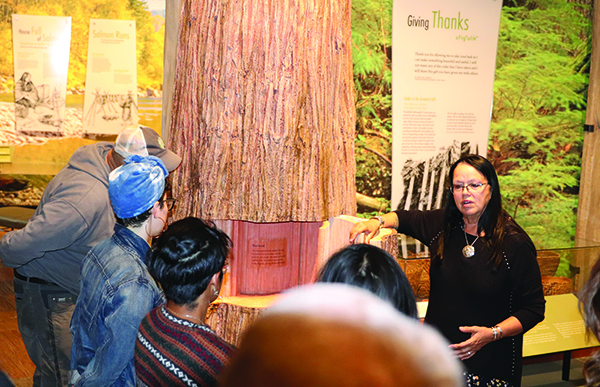
To get a basic understanding of generational trauma, Tulalip Elder and Natural Resources Special Projects Manager, Patti Gobin, began the presentation by sharing a personal family story about her grandma, Celum Young, who was a first generation Tulalip boarding school student. Patti explained that because of years of forced assimilation, Celum struggled with her identity after enduring years of physical abuse for speaking her language and practicing her traditions while at the boarding school. As a direct result from the boarding schools, Patti admitted that her grandmother avoided teaching her children and grandchildren certain traditions in fear that they would be punished just as she was. Over time, Celum and other boarding school students inadvertently passed their boarding school traumas onto the next generation and many Native families still struggle with generational trauma to this day.
Today, Patti and her family are very involved in the Tulalip culture, taking part and leading in a number of ceremonies and traditions, including stripping cedar every summer.
“Stripping cedar is a very critical part of our culture for weaving and many other purposes,” Patti said. “As we were stripping cedar one day, we sang our songs to thank the cedar trees for letting us have portions of its life to become a part of our lives. As we’re doing this, all we could hear was, zoom. Motor bikes were going by throughout the whole day we were there. One young man stopped and asked, ‘what are you doing here, are you cutting all these trees down?’ I said no we are stripping cedar, it a traditional way of our life. He said, ‘oh’, strapped on his helmet and zoom, he took off.”
Patti shared this particular story to explain how the Tribe’s treaty rights are often violated in today’s society. The 1855 Treaty of Point Elliot is a formal agreement between the federal government and the people who make up the central and north Puget Sound tribes, including the Snohomish, Snoqualmie, Skykomish and other allied bands. As direct descendants of the Snohomish, the Tulalips ceded millions of acres of land, agreeing to move their people to the present day Tulalip reservation. In return, the Tribe retained their rights to fish in their usual and accustomed grounds as well as hunt and gather on open and unclaimed lands in order to continue practicing their traditional cultural lifeways.
Because of the change in the environment since the industrial revolution, the Tribe is diligently working to preserve the natural world as much as possible by spearheading a number of projects like the Qwuloolt Estuary project as well as the Mount Baker-Snoqualmie Forest huckleberry restoration. The Tribe is also making strong efforts to continue teaching the next generations how to care for the land and the waterways at the annual Fish and Mountain Camps, so that the resources remain available for decades to come.
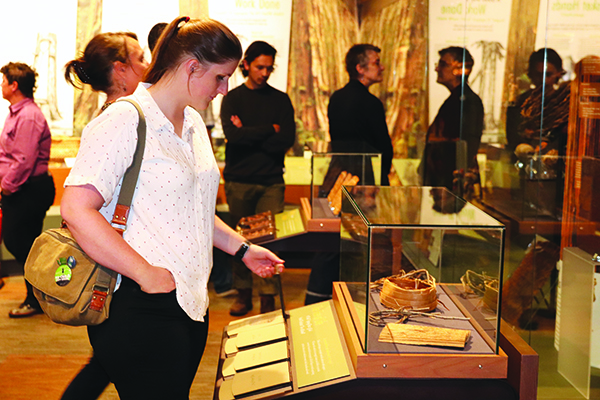
“If we’re able to exercise treaty rights in a forest, that means it’s a healthy forest,” explained Ryan. “If we’re able to fish in the salt water, then we know that we have at least some good health there. What we’re really looking at is, are we protecting these places enough that they support treaty rights, and if we are, then we’re headed in the right direction. It’s when we get to these places where tribes don’t have access to the resources, like they had before, then we know somethings wrong because we’ve been accessing those resources for thousands of years.”
Ryan went into depth, explaining the Treaty of Point Elliot to the environmentalists while also briefly touching on the Boldt Decision. During his presentation he reaffirmed that the treaties are the supreme law of the land according to the US Constitution, and that the federal government has an obligation to uphold and support the ideals agreed upon between the state and tribal people. A major eye-opener for the participants was that the treaty not only applies to them, but they also have a role and a duty to support the treaties of the Coast Salish tribes as well. They learned how the treaty can help protect the environment and how a number of projects that would negatively affect our quality of life were ultimately shut down because they were in violation of tribal treaty rights.
Natural Resources Senior Environmental Policy Analyst, Libby Nelson, also demonstrated an informational presentation, giving the group a look at how the increasing population of the state is attributing to climate change as well as affecting tribal hunting and gathering rights.
“A lot of these organizations are going to support tribes, they just don’t necessarily know about treaty rights, they don’t know about tribal lifeways,” Libby stated. “At a time where there’s so much growth in this area, we need allies. We got a climate that is changing and there’s a lot happening to the environment right now, we need to be on the same page. We think there’s a lot more room for coming together through learning about who the tribes are and what treaty rights are all about. And understanding that, not only is it the right thing to do, but also treaty rights are a powerful tool for ensuring that we don’t diminish further resources that are out there for everybody.”
After a Q&A session, the Natural Resources department handed out a list of principles and asked the environmental organizations to consider adopting and incorporating them, as well as modifying them to meet their own personal mission and values. A local non-profit, Forterra, gave a little insight to the group on how their organization adopted the list of principles and have developed a strong relationship with the Tribe. Ryan also stated that one of the recreational groups from the first treaty rights event has also adopted the principles, while several others groups are working with their board members to commit to the principles as well.
“I’m really hopeful that this is going to continue and expand, not only for us but for other tribes, and that it will have a real tangible impact on the relationships between our sovereign nations and governments, and also between our nations and all the non-governmental organizations that we partner with,” Ryan said. “One of the things we always want to be careful of and cognizant of is that this is Tulalip’s view, we only represent Tulalip, we do not represent other tribes. What we are trying to do is help create educational opportunities for these organizations and governments. We’re really hopeful that other tribes will pick up on this as well and that they’re going to push forward to do the same thing with the groups that work in their areas.”
“There was a lot of amazing information, especially for non-natives who are interested in supporting sovereign nations here in the state,” expressed Jacob DeGuzman of the Seattle Parks and Recreation department. “It reinforced knowledge I did know, like treaties are the supreme law of the land, but also highlighted aspects that I didn’t know, one of those being that the treaties benefit all of us. Ryan stated that as a Washington resident or a citizen of the United States, we are legally obligated to uphold those treaties and advocate for them. It helped us gain a much more expanded perspective of the land and the people that are still here caring for it.”
The Tulalip Natural Resources department is planning one more Understanding Treaty Rights event during the fall which will be specific to governmental entities of the Pacific Northwest. For more information, please contact Natural Resources at (360) 716-4480.
Please use the following link to download the June 29, 2019 issue of the syəcəb:
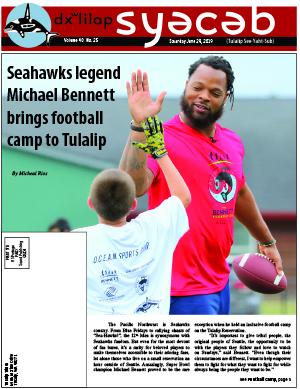
Please use the following link to download the June 22, 2019 issue of the syəcəb:
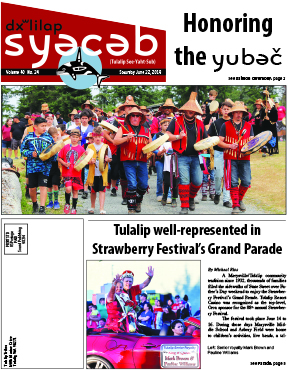
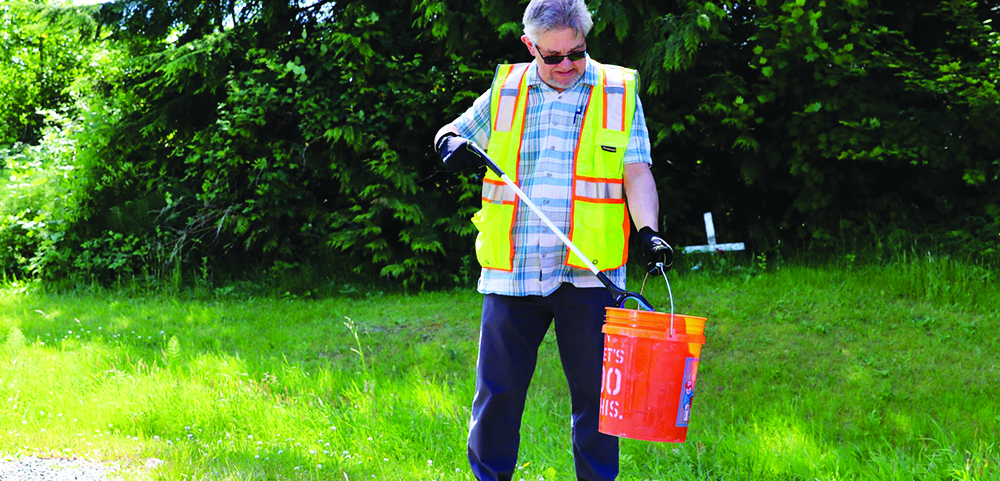
By Kalvin Valdillez, Tulalip News
On the morning of June 17, the Tulalip Real Estate department, as well as volunteers from the Planning department, were hard at work cleaning up the Silver Village neighborhood. The clean-up is the department’s second and biggest beautification project to date, where they perform basic maintenance upkeep such as landscaping and trash and debris removal at Tulalip housing developments.
“Today we’re doing a much-needed clean-up to show the community that we care about the condition of the neighborhoods,” said Larry Bergstrom, Interim Executive Director of Property Management. “We’re cleaning up common areas where we know people need help with the grass and we’re basically doing all the gutters along the street. We also provide large dumpsters and let the people know that they are going to be here, and that they’re free to come load it up with anything they got in their house that they need to get rid of.”
After a successful community clean up last year at the “Y-Site” neighborhood, the Real Estate department took on the bigger challenge at Silver Village and partnered with Tulalip Public Works, utilizing their mowers and weed whackers.
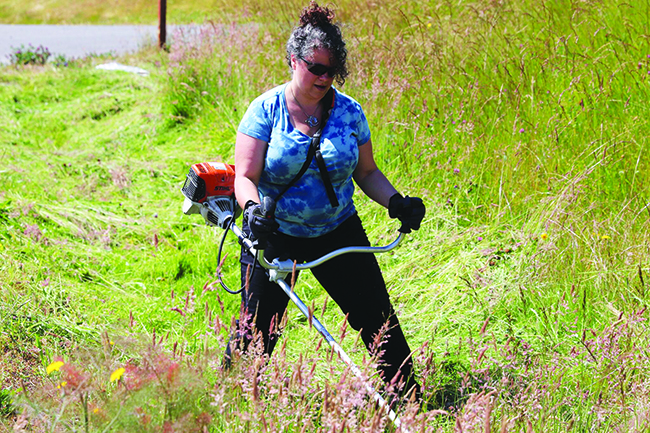
“These little things help,” stated Desiree Michael, Asset and Real Estate Manager. “Making sure we don’t have leaking oil, fluids, rusty metal and overgrown grass everywhere is a good start. We want to make sure that oil isn’t seeping into the ground because that eventually seeps into the water supply for the salmon. We’re really just doing our part, helping the environment because it needs to be done. It looks better, it’s better for drainage and it’s better for the development as a whole.”
The Real Estate and Planning departments organized a lunchtime BBQ to feed the local residents who helped out with the clean-up project. Unfortunately, the picnic was only enjoyed amongst coworkers as the team received no volunteers or assistance that morning. The department was happy, however, that many people were using the dumpsters as well as placing large unwanted items on their curbside for the Real Estate department to pick up and deliver to the dump.
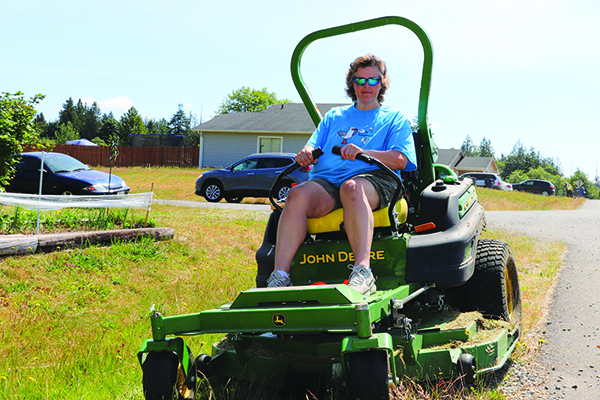
“We encouraged the residents to help but we haven’t gotten any volunteers yet,” Larry said. “But we’ll be back on Friday (June 21) because this is a big site and hopefully we’ll get more participation. We’re really just hoping to instill a little more pride in the neighborhood for the people.”
“I wish that the residents would come out and participate too,” added Desiree. “We posted fliers, we knocked on doors, we tried to get them involved. It’s Larry’s goal to do these clean-ups at each of the developments, I just hope the residents will jump in, help us out and get involved in their neighborhoods.”
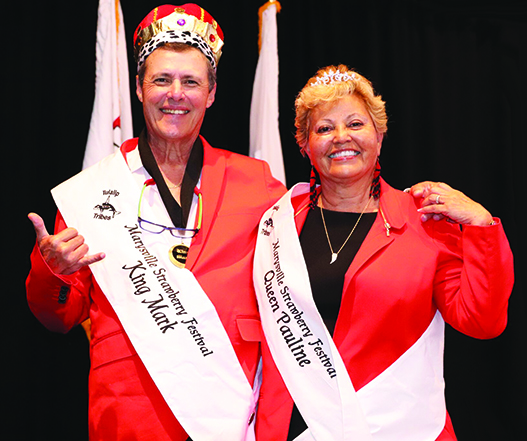
By Kalvin Valdillez, Tulalip News
In the Orca ballroom of the Tulalip Resort and Casino, elders representing many different tribal nations gathered on June 13 for an afternoon of gab, grub and gifts. An estimated 1,200 Indigenous wisdom keepers journeyed to Tulalip for the Tribe’s popular annual Elder’s Luncheon.
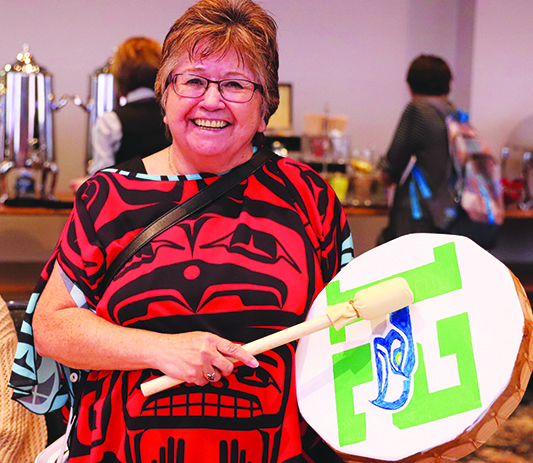
Laughter was shared throughout the event as Tulalip Board of Director Mel Sheldon provided witty jokes and tidbits while on emcee duty. Elders from near and far enjoyed each other’s company for hours. Several vendor stations were set-up across the hall, in the Chinook ballrooms, selling a variety of items including beaded jewelry, blankets, artwork and accessories.
“We come here every year,” exclaimed Kalispel tribal elder, Wilma Bowman. “We actually got here a day early and spent the night, we’ll stay again tonight. I love this luncheon because they have vendors, very good food and this is my favorite tribal hotel. I just love how it’s designed to represent their culture outside and in. There was a time where you couldn’t do this because it wasn’t a fast paced world. You could only really visit with neighboring tribes but now you can travel a long ways and visit with elders from other tribes.”
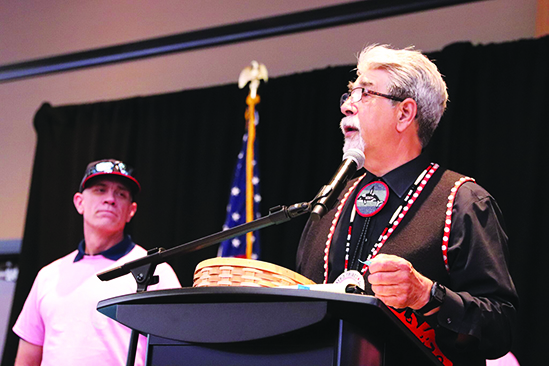
The elders were fed a delicious salmon lunch while they listened for their raffle ticket numbers to be called. This year, the Tribe raffled off a number of giveaway items including 32” & 55” TVs, KitchenAid mixers, cash, mini refrigerators, Keurig coffee makers and gift baskets donated by several Tulalip tribal and TGO departments.
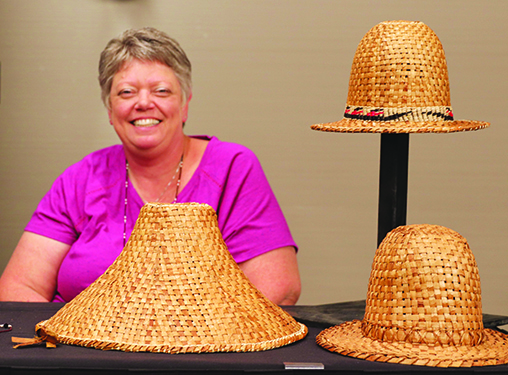
The Marysville Strawberry Festival Tulalip Senior Royalty, Mark Brown and Pauline Williams, were crowned as King and Queen during the Luncheon. With their crowns held high and their sashes proudly on display, the couple happily accepted their naming and showcased their graceful, royal waves to their fellow elders.
“It’s an honor,” expressed Queen Pauline. “Especially because my mother was once up on that stage, in about 2001, 2002. Her name is Florence Gladys McKay and she received the same honor. I haven’t lived here all my life. I left when I was about seventeen and ended up in Texas and met my husband. Now I’ve come full circle and came home. This luncheon is always great because you get to meet people from all over. We try to go to a few other luncheons too, at different tribes, Spokane and Coeur d’Alene.”
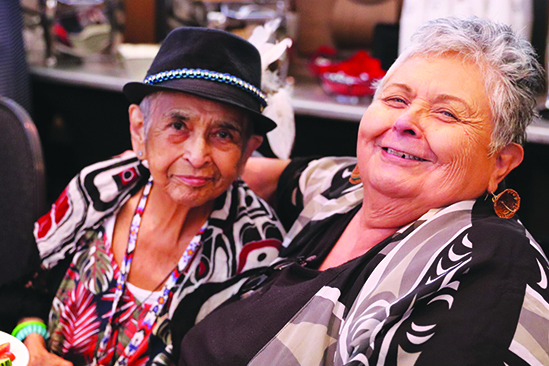
After the grand prize, the 55” Smart TV, was gifted, the elders said their goodbyes, exchanged information and shared hugs. Many of the elders who were staying another night made plans for dinner and gaming after a fun afternoon at the luncheon.
“I think it’s important for the elders to come together every year,” said Elisha Stewart, Elders Service Case and Program Manager. “It seems like the only time our communities come together is because of a loss or tragedy. So coming together to celebrate them is important, their presence is good medicine and when they bring that to our community, it’s priceless.”

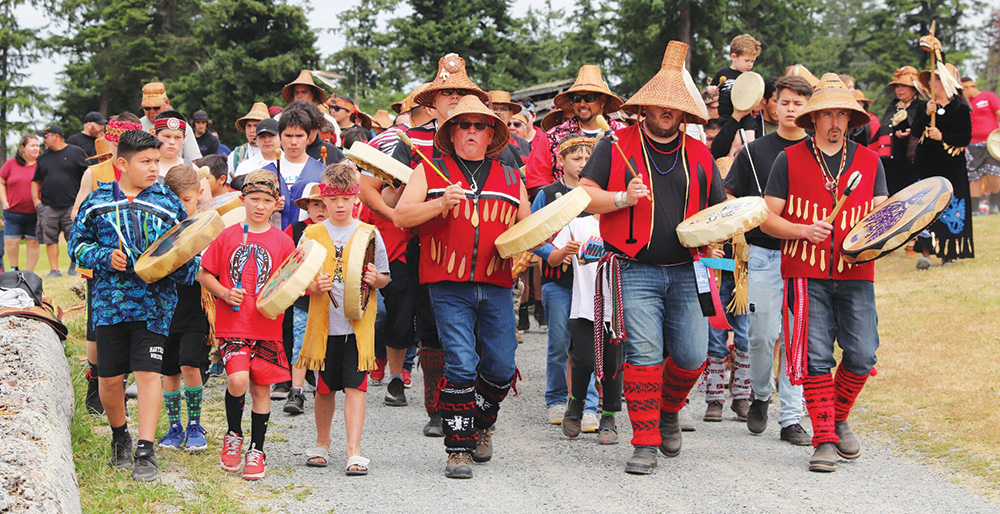
By Kalvin Valdillez, Tulalip News
Smoke billowed from the Tulalip Longhouse on the overcast morning of June 15. On the inside, a circle of traditional dancers moved in a counterclockwise motion to the sounds of strong drumbeats and melodies sang in the traditional Lushootseed language. As the singers began the final chorus, a young man rushed out of the longhouse, asking people who were outside, “is he coming, can you see him?”
Two younger kids joined the youth’s quest as he ran to the edge of the bluff overlooking Tulalip Bay.
“There he is,” he exclaimed and then ran back into the longhouse to report that the honored guest was nearby.
Moments later, the Tulalip singers and dancers emerged from the longhouse and began walking toward the shore of the bay. Draped in Coast Salish garb, tribal members continued to drum and sing, welcoming the visitor to the community.
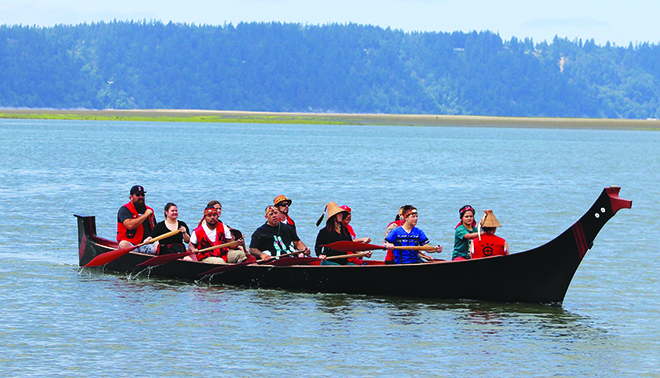
Transported on the sacred Tulalip cedar canoe, Big Brother, the guest laid upon a bed of cedar branches.
Every year, the Tulalips continue to uphold a tradition that was revived by Harriette Shelton Dover during the late seventies, after it was nearly lost due to years of forced assimilation. The Salmon Ceremony, is an annual event that welcomes the first yubəč, or king salmon, of the fishing season. The honoring is held not only to ensure that Tulalip fisherman have a safe year on the waters, but also to thank the salmon for graciously providing the Tribe with sustenance since time immemorial.
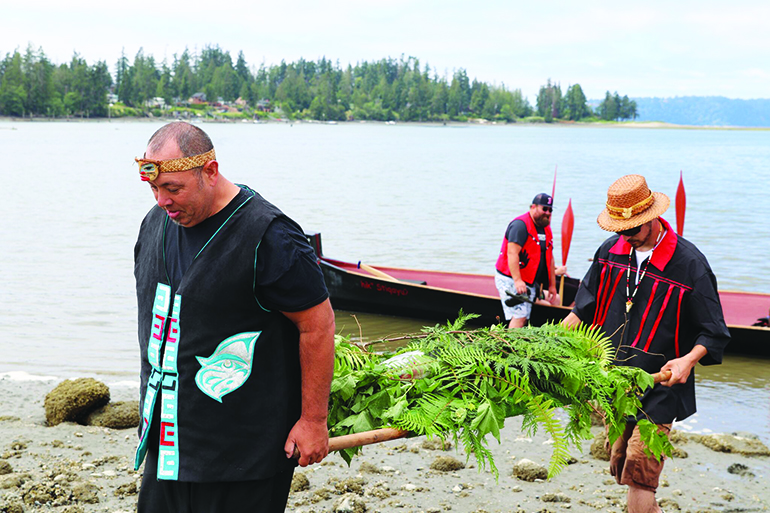
“We honor the gift of our visitor, yubəč, Big Chief King Salmon,” said Tulalip Board of Director and Salmon Ceremony leader, Glen Gobin. “We’re harvesting from nature again, it’s how we honor and respect that, to en sure that he’s always going to be there. Him and his people will always be there, returning to take care of our people as they always have.”
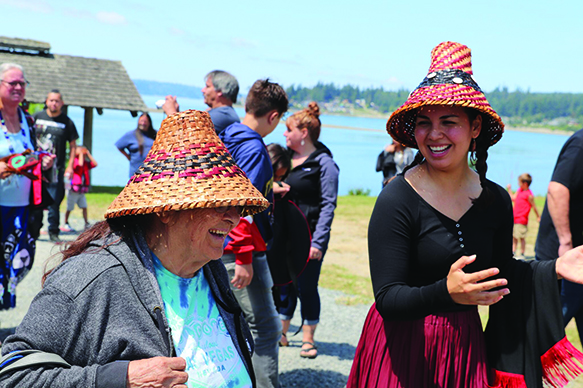
The king salmon is brought ashore from the Salish waters as tribal members offer a welcoming song. The yubəč is carried into the longhouse where the traditional singers and dancers perform a blessing for the guest.
When the blessing is complete, the festivities continue at the Greg Williams Court where Salmon Ceremony participants and spectators are treated to a delicious salmon meal. Once everybody is well-fed, the visitor is sent back to the water to return to its community and tell its people of the Tribes’ hospitality. In return, many salmon will journey to Tulalip’s waters throughout the season to feed the community because of the honor and respect shown during the ceremony.
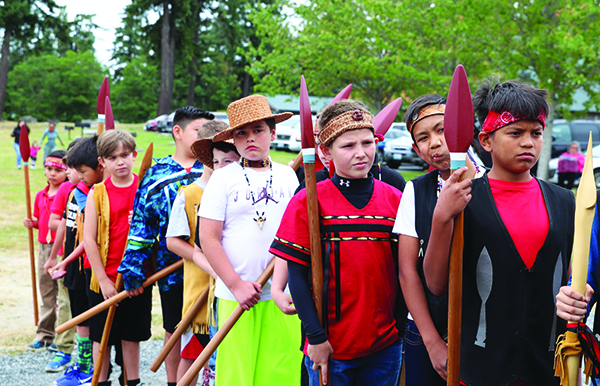
After another successful honoring, Glen reflected on this year’s ceremony, proudly beaming about the amount of participation from local youth.
“It’s important that our young ones understand our teachings, our traditions and where they come from,” said Glen. “So much has been lost and taken away that we’re not left with what was originally there, but we do the best we can. It’s really encouraging to see the smiles on their faces when they come and they’re wanting to participate. Nobody makes them do anything, they come here out of a desire within themselves. I liken it to when I was young and heard the beat of a drum, I was just drawn to it. I see that in these young ones. When they see bits and pieces of our culture and then they get to participate in it, they understand what ownership of it means. If they have that, then we’re ensured for the next generations.”
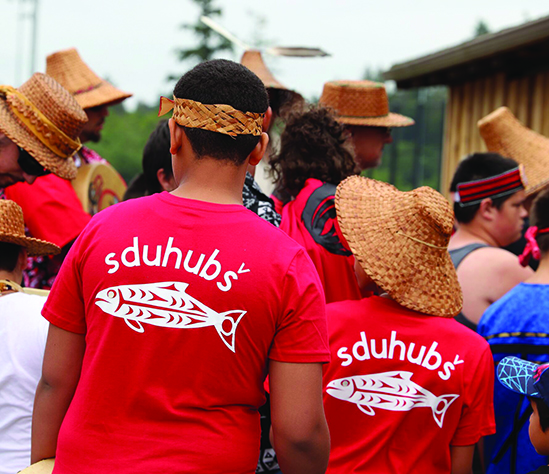
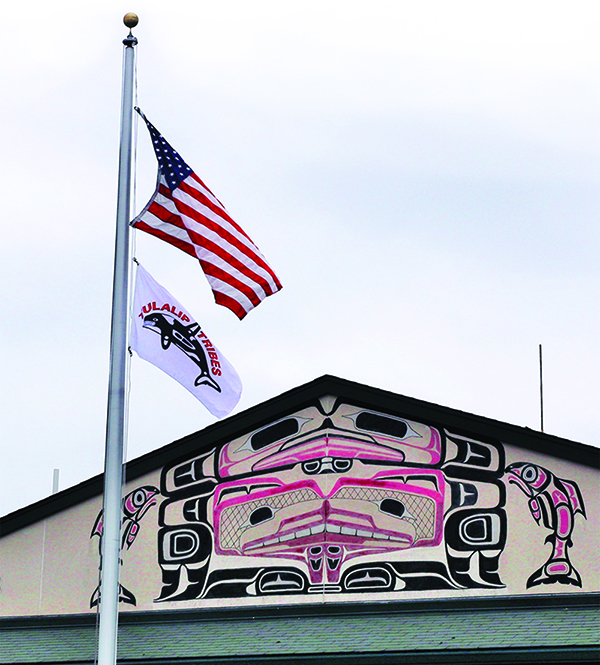
By Micheal Rios, Tulalip News
Outside the front entrance of Quil Ceda Tulalip Elementary is a flag pole that, since its inception, had one purpose and one purpose only – to fly the red, white and blue United States flag. As of June 14, that singular purpose is no longer and a once lone U.S. flag is now joined by the resilient and bold orca symbolizing the Tulalip Tribes.
“Beginning today, the Tulalip Tribes flag will be flying at QCT every day, right along with our American flag,” said Assistant Principal J.J. Jensen during the school’s morning assembly. “We want our community, our students and their families to know that when they are here, they are on sovereign Tulalip land.”
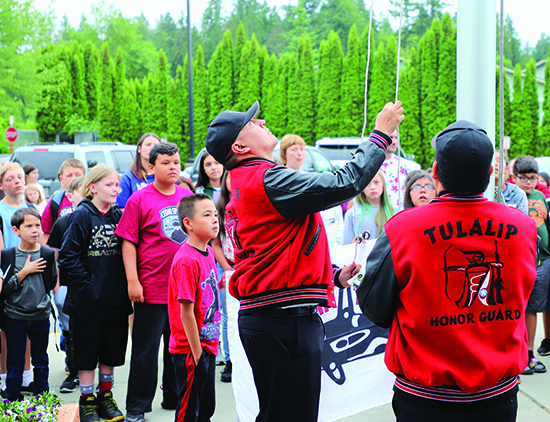
“We are very unique in that we are a sovereign nation,” added Tulalip tribal member and Cultural Specialist, Chelsea Craig. “Our flag is so important because it represents our people who make up the Tulalip nation. Our flag also honors our veterans, those who chose to serve and those who sacrificed their lives so we can all be here today.”
On May 30, 1916, President Woodrow Wilson issued a presidential proclamation establishing a national Flag Day on June 14. The day commemorates the adoption of the stars and stripes as the official flag of the United States. Fast forward 103 years to the Flag Day celebration at Tulalip’s on-reservation elementary, where staff, students and Tulalip veterans assembled to recognize not only the importance of U.S. nationhood, but tribal sovereignty as well.
Led by students proudly holding the Tulalip flag, and followed by young drummers and singers sharing their culture through song, the school assembly routed via the gymnasium to the main entrance’s flag pole. The student body remained respectfully silent as the honor guard raised the U.S. and Tulalip flags while a trumpet rendition of ‘Reveille’ played.
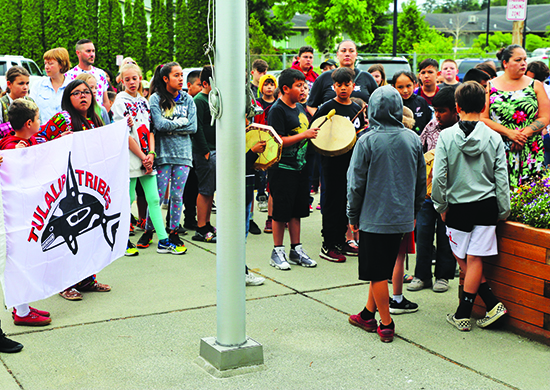
“It was the first time we’ve ever been asked to do a flag raising ceremony here at Tulalip. It was a great honor,” said William McLean III, Veterans Coordinator, standing beside fellow veteran Rocky Renecker following the assembly. “For the students here, we hope today introduces them to the fact that flags mean something, they aren’t just pieces of cloth floating in the air. Both these flags are near and dear to our hearts and represent why we chose to serve in the military.”
For the hundreds of students that pass by the school’s flagpole every day, the Tulalip Tribes flag waving in the wind over Quil Ceda Tulalip Elementary serves as a subtle example of sovereignty in action.